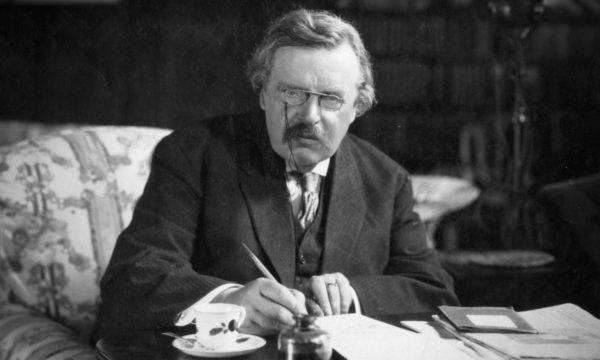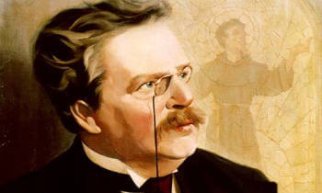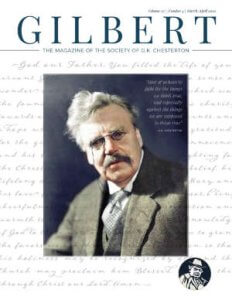Let it be understood that I write this article as one wholly conscious that he has failed to write a detective story. But I have failed a good many times. My authority is therefore practical and scientific, like that of some great statesman or social thinker dealing with Unemployment or the Housing Problem. I do not pretend that I have achieved the ideal that I set up here for the young student; I am, if you will, rather the awful example for him to avoid. None the less I believe that there are ideals of detective writings, as of everything else worth doing; and I wonder they are not more often set out in all that popular didactic literature which teaches us how to do so many things so much less worth doing; as, for instance, how to succeed. Indeed, I wonder very much that the title at the top of this article does not stare at us from every bookstall. Pamphlets are published teaching people all sorts of things that cannot possibly be learnt, such as personality, popularity, poetry, and charm. Even those parts of literature and journalism that most obviously cannot be learnt are assiduously taught. But here is a piece of plain straightforward literary craftsmanship, constructive rather than creative, which could to some limited extent be taught and even, in very lucky instances, learnt. Sooner or later I suppose the want will be supplied, in that commercial system in which supply immediately answers to demand, and in which everybody seems to be thoroughly dissatisfied and unable to get anything he wants. Sooner or later, I suppose, there will not only be text-books teaching criminal investigators, but text-books teaching criminals. It will be but a slight change from the present tone of financial ethics, and when the shrewd and vigorous business mind has broken away from the last lingering influence of dogmas invented by priests, journalism and advertisement will show the same indifference to the taboos of today as does today to the taboos of the Middle Ages. Burglary will be explained like usury, and there will be no more disguise about cutting throats than there is about cornering markets. The bookstalls will be brightened with titles like ‘Forgery in Fifteen Lessons,’ and ‘Why Endure Married Misery?’ with a popularization of poisoning fully as scientific as the popularization of Divorce and Birth-Control.
But, as we are so often reminded, we must not be in a hurry for the arrival of a happy humanity; and meanwhile, we seem to be quite as likely to get good advice about committing crimes as good advice about detecting them, or about describing how they could be detected. I imagine the explanation is that the crime, the detection, the description, and the description of the description, do all demand a certain slight element of thought, while succeeding and writing a book on success in no way necessitate this tiresome experience. Anyhow, I find in my own case that when I begin to think of the theory of detective stories, I do become what some would call theoretical. That is, I begin at the beginning, without any pep, snap, zip or other essential of the art of arresting the attention, without in any way disturbing or awakening the mind.
The first and fundamental principle is that the aim of a mystery story, as of every other story and every other mystery, is not darkness but light. The story is written for the moment when the reader does understand, not merely for the many preliminary moments when he does not understand. The misunderstanding is only meant as a dark outline of cloud to bring out the brightness of that instant of intelligibility; and most bad detective stories are bad because they fail upon this point. The writers have a strange notion that it is their business to baffle the reader; and that so long as they baffle him it does not matter if they disappoint him. But it is not only necessary to hide a secret, it is also necessary to have a secret; and to have a secret worth hiding. The climax must not be an anti-climax; it must not merely consist of leading the reader a dance and leaving him in a ditch. The climax must not be only the bursting of a bubble but rather the breaking of a dawn; only that the daybreak is accentuated by the dark. Any form of art, however trivial, refers back to some serious truths; and though we are dealing with nothing more momentous than a mob of Watsons, all watching with round eyes like owls, it is still permissible to insist that it Is the people who sat in darkness who have seen a great light; and that the darkness is only valuable in making vivid a great light in the mind. It always struck me as an amusing coincidence that the best of the Sherlock Holmes stories bore, with a totally different application and significance, a title that might have been invented to express this primal illumination; the title of “Silver Blaze”.
The second great principle is that the soul of detective fiction is not complexity but simplicity. The secret may appear complex, but it must be simple; and in this also it is a symbol of higher mysteries. The writer is there to explain the mystery; but he ought not to be needed to explain the explanation. The explanation should explain itself; it should be something that can be hissed (by the villain, of course) in a few whispered words or shrieked preferably by the heroine before she swoons under the shock of the belated realization that two and two make four. Now some literary detectives make the solution more complicated than the mystery, and the crime more complicated than the solution.
Thirdly, it follows that so far as possible the fact or figure explaining everything should be a familiar fact or figure. The criminal should be in the foreground, not in the capacity of criminal, but in some other capacity which nevertheless gives him a natural right to be in the foreground. I will take as a convenient case the one I have already quoted; the story of Silver Blaze. Sherlock Holmes is as familiar as Shakespeare; so there is no injustice by this time in letting out the secret of one of the first of these famous tales. News is brought to Sherlock Holmes that a valuable race-horse has been stolen, and the trainer guarding him murdered by the thief. Various people, of course, are plausibly suspected of the theft and murder; and everybody concentrates on the serious police problem of who can have killed the trainer. The simple truth is that the horse killed him. Now I take that as a model because the truth is so very simple. The truth really is so very obvious.
At any rate, the point is that the horse is very obvious. The story is named after the horse; it is all about the horse; the horse is in the foreground all the time, but always in another capacity. As a thing of great value he remains for the reader the Favourite; it is only as a criminal that he is a dark horse. It is a story of theft in which the horse plays the part of the jewel until we forget that the jewel can also play the part of the weapon. That is one of the first rules I would suggest, if I had to make rules for this form of composition. Generally speaking, the agent should be a familiar figure in an unfamiliar function. The thing that we realize must be a thing that we recognize; that is it must be something previously known, and it ought to be something prominently displayed. Otherwise there is no surprise in mere novelty. It is useless for a thing to be unexpected if it was not worth expecting. But it should be prominent for one reason and responsible for another. A great part of the craft or trick of writing mystery stories consists in finding a convincing but misleading reason for the prominence of the criminal, over and above his legitimate business of committing the crime. Many mysteries fail merely by leaving him at loose ends in the story, with apparently nothing to do except to commit the crime. He is generally well off, or our just and equal law would probably have him arrested as a vagrant long before he was arrested as a murderer. We reach the stage of suspecting such a character by a very rapid if unconscious process of elimination. Generally we suspect him merely because he has not been suspected. The art of narrative consists in convincing the reader for a time, not only that the character might have come on the premises with no intention to commit a felony, but that the author has put him there with some intention that is not felonious. For the detective story is only a game; and in that game the reader is not really wrestling with the criminal but with the author.
What the writer has to remember, in this sort of game, is that the reader will not say, as he sometimes might of a serious or realistic study: “Why <did> the surveyor in green spectacles climb the tree to look into the lady doctor’s back garden?” He will insensibly and inevitably say, “Why did the author <make> the surveyor climb a tree, or introduce any surveyor at all?” The reader may admit that the town would in any case need a surveyor, without admitting that the tale would in any case need one. It is necessary to explain his presence in the tale (and the tree) not only by suggesting why the town council put him there, but why the author put him there. Over and above any little crimes he may intend to indulge in, in the inner chamber of the story, he must have already some other justification as a character in a story and not only as a mere miserable material person in real life. The instinct of the reader, playing hide-and-seek with the writer, who is his real enemy, is always to say with suspicion, Yes, I know a surveyor might climb a tree; I am quite aware that there are trees and that there are surveyors, but what are you doing with them? Why did you make this particular surveyor climb this particular tree in this particular tale, you cunning and evil-minded man?”
This I should call the fourth principle to be remembered, as in the other cases, people probably will not realize that it is practical, because the principles on which it rests sound theoretical. It rests on the fact that in the classification of the arts, mysterious murders belong to the grand and joyful company of the things called jokes. The story is a fancy; an avowedly fictitious fiction. We may say if we like that it is a very artificial form of art. I should prefer to say that it is professedly a toy, a thing that children ‘pretend’ wish. From this it follows that the reader, who is a simple child and therefore very wide awake, is conscious not only of the toy but of the invisible playmate who is the maker of the toy, and the author of the trick. The innocent child is very sharp and not a little suspicious. And one of the first rules I repeat, for the maker of a tale that shall be a trick, is to remember that the masked murderer must have an artistic right to be on the scene and not merely a realistic right to be in the world. He must not only come to the house on business, but on the business of the story; it is not only a question of the motive of the visitor but of the motive of the author. The ideal mystery story is one in which he is such a character as the author would have created for his own sake, or for the sake of making the story move in other necessary matters, and then be found to be present there, not for the obvious and sufficient reason, but for a second and a secret one. I will add that for this reason, despite the sneers at ‘love-interest’ there is a good deal to be said for the tradition of sentiment and slower or more Victorian narration. Some may call it a bore, but it may succeed as a blind.
Lastly the principle that the detective story like every literary form starts with an idea, and does not merely start out to find one, applies also to its more material mechanical detail. Where the story turns upon detection, it is still necessary that the writer should begin from the inside, though the detective approaches from the outside. Every good problem of this type originates in a positive notion, which is in itself a simple notion; some fact of daily life that the writer can remember and the reader can forget. But anyhow, a tale has to be founded on a truth; and though opium may be added to it, it must not merely be an opium dream.





